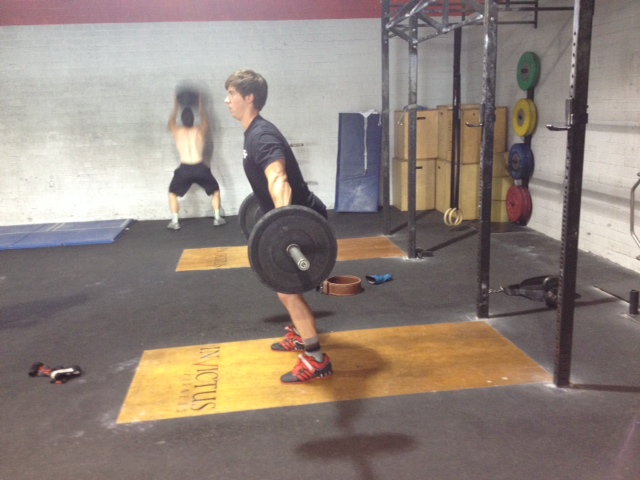Take 15-20 minutes to cycle through and practice various gymnastics elements that you need to work on – examples . . . Pistol Progressions x 4-6 reps each leg, Handstand Holds or Walks (freestanding or supported) x 60-90 seconds, L-Sits x 30-60 seconds, L-Pull-Ups, etc…
B.
Complete rounds of 21, 15 and 9 reps for time of:
Thrusters (135/95 lbs)
Pull-ups
Burpees
Registration for the CrossFit Team Series is open.
The Proper High Hang Position
The Proper High Hang Position
Written by Cody Burgener
When it comes to teaching the Olympic lifts to a new client, there
are three fundamentals that we try to grind into their brains: stance,
grip, and positions. But the fundamental that I really want to talk
about today is positions.Written by Cody Burgener
Positions are crucial when it comes to the Olympic lifts. Being out of the correct position can have a catastrophic effect on your lifts. It can make the bar pull your body forward or it can cause you to swing the bar away from your body. You may also pull with your arms to soon or end up jumping forward – I can go on and on. There are three different positions that I want to go over during my next series of blog posts: the high hang, the launch/mid-thigh/hang position, and floor.
In the high hang position, there a couple points of performance that we want to happen while performing a high hang snatch/clean or a jerk. We want to keep our shoulders behind the bar the whole time we are dipping and driving. We want to stay on our heels as we dip and drive. We want to drive off our heels for as long as possible until the momentum of our hips and knees (moving vertically) brings us up onto our toes. Last but not least, we want to have a short dip as we dip and drive. Think about how you dip for a push press; the dip for the high hang snatch/clean should be the same depth.
Now that you know the points of performance that we are looking for in a high hang positions, lets talk about mistakes that you are going to see in this position. One of the major ones is going to be the weight shifting towards the ball of their foot. What is the weight trying to do to us when we are holding it? It’s trying to pull us down and forward. When we shift to the balls of our feet, we are letting the bar win by pulling us forward from the get go. This is going to make us jump with our chest over the bar, resulting in us having to try and jump forward to catch up to the bar. We want to try a counterbalance that weight, and the only way we can succeed in doing that is making sure we stay back on our heels. The heavier the weight, the more you might have to stay back on your heels.
The second major problem you will see clients do is letting the shoulders come in front of the bar as you dip. This will happen when the client pushes his hips back. We are trying to get those hips to move vertically. By clients pushing their hips back first, they have the capability to swing the bar out because the hips are moving horizontally instead of vertically. Which, in the long run, will cause the client to jump forward because he has to try and catch up to the bar. We want a brush with the hips, not a bang.

